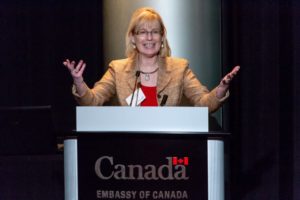
By JANINE FINNELL
A number of cities and states in the greater Washington Metropolitan region are enacting innovative approaches to become carbon neutral, transition to a clean economy including zero waste, and create enhanced economic opportunities for all citizens through green careers and jobs.
These topics were discussed by a diverse panel of energy, economic development, and employment experts from across the District of Columbia, Maryland, and Virginia (DMV) on growing a clean economy and jobs at the Leaders in Energy 6th Annual Green Jobs Forum for a Low-Carbon, Circular Economy, August 22, 2019, at the Metropolitan Washington Council of Governments. The event included green career and networking workshops, exhibitors hiring in the green economy, educators and career assistance organizations, and two panels with 120+ attendees.
The speakers included:
- Tommy Wells, Director, District of Columbia, Department of Energy and Environment
- Samuel Beirne, Energy Program Manager, Maryland Energy Administration
- Alex Cooley, Manager, Labor Information Services, Northern Virginia Community College
- Emily Yates, Founder + Principle of Urban Revolution Group (Charlotte, NC)
The panel was moderated by Janine Finnell, Executive Director, Leaders in Energy. She presented an overview on the low carbon and circular economy and its potential for job creation and economic development which is available here.
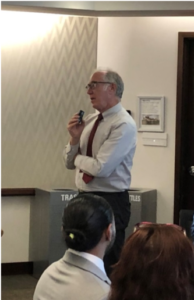
Steve Walz from the Metropolitan Washington Council of Government welcomed the attendees.
View the panel video here.
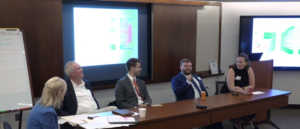
(from l-r) Janine Finnell, Tommy Wells, Samuel Beirne, Alex Cooley, and Emily Yates (Photo Credit: from YouTube Video produced by FilmBison Media)
Growing the Green Economy in DC
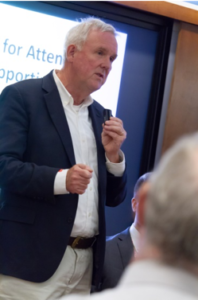 “The amount of the economy that’s being generated through our green aspirations, but also through regulations and requirements to have a green city, is extraordinary.” Tommy Wells, Director, District of Columbia, Department of Energy and Environment
“The amount of the economy that’s being generated through our green aspirations, but also through regulations and requirements to have a green city, is extraordinary.” Tommy Wells, Director, District of Columbia, Department of Energy and Environment
Tommy Wells posed the question on what exactly is a green economy and discussed how he thinks about it through the lens of a “green ledger,” comprised of revenue, expenditures, and economic activity. He says that the green economy in District of Columbia (DC) will amount to $8-10 billion over the next 15 years.
What Does the Green Economy Look Like in DC?
He provided a number of examples including Mayor Bowser’s Solar for All initiative which he says generates economic activity in a number of ways — the costs of solar panels, the solar renewable energy credits, the income tax credits, the savings on the cost of your power, the depreciation of equipment, which in turn creates a whole economic cycle. He says that the Public Utility Commission estimates that in the next 15 years, this program will contribute $1.4 billion to the economy.
Another example is stormwater management and its contribution to the green economy. The base cost for the tunnel program is $2.5 billion and with the interest on the bonds, this tallies to $4 billion. Stormwater management also involves the use of bioswales[1]and a workforce is needed to both install and manage these. In addition, small companies of different sizes, manage the trees and greenery on top of these buildings which also generate economic activity. Mr. Wells states that, “The amount of the economy that’s being generated through our green aspirations, but also through regulations and requirements to have a green city, is extraordinary.”
He emphasized the important role of the Clean Energy DC bill which was signed into law in January 2018 by Mayor Bowser. While incentives are important to change behavior to retrofit buildings or build new buildings around environmental goals, he underscored that DC is the first jurisdiction in the nation to include fines for noncompliance. He thinks that in America more progress is made through direct regulation like CAFE standards[2]than just with incentives. DC now has Building Energy Performance Standards where building energy efficiency will keep increasing and that this will have an economic impact on the city over the next 15 to 20 years of another two to five billion dollars.
Moving to a Cleaner, Greener City
DC is requiring that all electricity comes from renewable sources by 2032. He discussed how there are enough renewable energy credits out there on the PJM grid right now where DC can be 100% renewable. However the challenge is to get to the additionality[3]on the grid.
The DOEE is working to achieve Mayor Bowser’s vision to become carbon neutral by 2050. This will create a whole new consumer base for the offshore wind turbines that are being built and for the solar collectors that are being installed on brownfields. This economic activity creates incredible opportunities for new businesses and jobs. He noted that about 15 years ago, there were two solar companies in DC ─ there are now 40 related solar companies in DC.
Cities Need to Provide the Leadership
Mr. Wells stated that: “There is a green economy and it’s good. It’s not just some surcharge for making people participate in being green, cities are going to have to provide the leadership and also the opportunities and the capacity so businesses within our jurisdictions can fully participate in this new economy. ”
He talked about new innovations involving battery technology and microtransit. (See more on these topics in the video session).
He noted the growth in his department over the past 5 years, growing in employees and budget. When Mr. Wells came to the DC Department of Energy and Environment about five years ago, there were 350 employees with a budget of $118 million. There are now 420 employees with a budget of $180 million. It’s almost all the growth on the energy side.
One of his first actions was the creation of a graduate-level Green Fellows program. Four to six fellows are accepted to help grown new leadership. He also said that the DC Department of Energy and Environment is always hiring.
It’s A Whole New Frontier
Mr. Wells said that DC is a major tech area. Figuring out data management around energy and demand management at a micro and macro scale is the frontier right now. There is also tremendous amount of opportunity in the modeling and figuring out how this works together. This is a fast moving field. How we model around battery usage today is going to be different in about a year because the batteries are changing so quickly. Our biggest challenge is getting peak power down. The jobs and the investments are wide open and at every single level. It’s a whole new frontier. Find DOEE job opportunities on the web at doee.dc.gov/greenpathways and follow us on Twitter and Instagram @DOEE.DC.
Clean Energy Jobs in Maryland
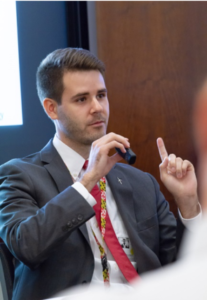
“Consider working for state government when looking for energy policy jobs” (Samuel Beirne, Energy Program Manager, Maryland Energy Administration)
Sam Beirne discussed Maryland’s landmark energy bill that passed this year – the Clean Energy Jobs Act 2019, also known as SB516. The bill increased the renewable portfolio standard from 25 percent by 2020 to 50 percent by 2030, with a carve-out for solar that was increased about 2.5 percent to 14.5 percent. There is also a carve-out for offshore wind that was 2.5 percent and now is up to 10 percent.
Other items included in the bill were $ 7 million which would be transferred from the Energy Investment Fund to the Maryland Department of Commerce, largely for grants or loans to small minority-owned businesses that are engaged in the clean energy industry in the state of Maryland. In addition, there was another $8 million that will be transferred to the Maryland Department of Labor. Three apprentice programs will be financed, as well as an additional $ 6.5 million for youth apprenticeship programs. Funding is also being provided for the EARN program, which is a nationally recognized workforce training program in the state of Maryland. The bill also requires a full study for the state transition its economy to a 100 percent clean and renewable economy by 2050.
Governor Hogan is putting together a plan to get the state to 100 percent renewable energy. In addition, he announced a land-based wind and solar siting task force to help resolve issues pertaining to land use in local communities.
Jobs from Off-Shore Wind Energy
Mr. Beirne thinks that the expected job creation of 20,000 jobs is going to occur when new renewable energy projects move through the entire pipeline from construction, operation, and maintenance. To give a quick example, about two years ago, Maryland approved two offshore wind projects of approximately368 megawatts. Those projects were estimated to generate about 9,700 full-time jobs equivalent over the lifetime of those projects.
Mr. Beirne mentioned that the Maryland Energy Administration is currently hiring for two positions. He passed along some helpful advice that he received several years ago in DC upon graduating from high school. Rather than solely examining the federal level in terms of policy, there are also numerous major energy major issues going on at the state level. He said within 10 months after graduating from college, he got a job in the state office that he wanted to work in.
The Green Economy and Jobs in Virginia
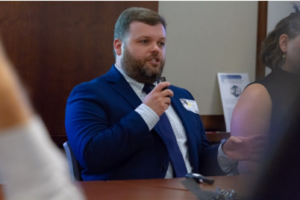
“Last year, there were five hundred jobs in northern Virginia in green jobs that were being advertised. A lot of them were with the federal government and the government contractors and also some private companies and local and state governments.” (Alex Cooley, Manager, Labor Information Services, Northern Virginia Community College)
Alex Cooley is a labor market information specialist who studies the economy as it relates to employment for a couple of reasons. One is to make sure that the curriculum that the Northern Virginia Community College (NVCC) is teaching its college students aligns with the needs of employers. Secondly, is to make sure that employers are hiring students or offering them internships or work as learning programs or jobs. And third, to make sure that we are reaching out to the K-12 education system and making sure that those students are making informed decisions about what they want to study and what they want to do with their future careers.
He reported that last year, there were five thousand jobs in northern Virginia in green jobs that were being advertised. Many of them were with the federal government, government contractors, and also some private companies and local and state governments. D.C. ranked fourth in the country last year in terms of number of green jobs that employers are looking to fill. So there’s a lot of activity in this region, not only in northern Virginia, but in Maryland and D.C. (NOTE: Other higher ranked areas for green jobs were Los Angeles and New York City)
He said that it surprised him a bit to learn about the employers that are hiring for green of jobs as D.C. is very unlike every other city in the country for a lot of reasons. Not only does it offer the energy job that individuals might find in other cities, DC also has the policy and legal and the legislative and the Federal government all tied up into that. And then we even have the private sector companies that are headquartered here which are not related to the government.
In northern Virginia, there is a plethora of America’s corporate headquarters. They recruited for fifty-five great jobs during the past year. He commented that there are things that you might not have thought about living in northern Virginia. We kind of think of ourselves as a tech, you know, very tech heavy, very government contractor. But a lot of government contractors are also very interested in green jobs. Boeing is one example. It had about 100 job postings over the last year for green jobs in both its Arlington and Seattle offices.
Other opportunities in the green space including the hospitality sector like Marriot and Hilton. There are also all the local governments and the state governments and a lot of education and policy think tank organizations. Mr. Cooley is also very interested in clean energy and renewable fuels and electric vehicles in terms of their job creation potential.
Circular Charlotte
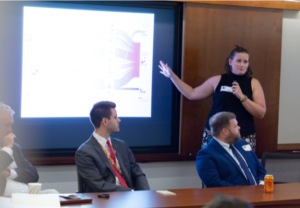
“The only way to become a more circular city is to understand what you are throwing away….I’ve been trying since 2014 to get cities in the US to transition to a more circular state.” Emily Yates, Founder + Principle of Urban Revolution Group (Charlotte, NC)
Emily Yates is the founder and principal of the Urban Revolution Group. The Group’s mission is to strategically position cities to capture economic opportunities while accelerating the transition to a low-carbon future.
Finding Her Passion in the Circular Economy
The reason she presented at the Forum was to share what she learned in the development of two catalytic programs when she worked for a small NGO in Charlotte, North Carolina. One was a strategic energy action plan which provided a road map for Charlotte to achieve the Paris Climate Accord Agreement to similarly reduce the city’s greenhouse gas emissions in line with the Paris targets. And she also led the development of Circular Charlotte, a circular economy strategy for Charlotte. It is the first city in the US to have a citywide strategy with a road map to becoming a more circular city.
She moved to Charlotte after having worked here in DC for the German Marshall Fund which is where she first was introduced to the circular economy concept which is a huge policy topic in Europe. She ended up taking policymakers and practitioners from Torino, Italy, Pittsburgh, and Charlotteto Amsterdam to see circular in action. And that was really where her passion was born. She has been trying since 2014 to get cities in the US to transition to a more circular state and was really excited that she could report on her experience from the cit y of Charlotte at our Forum.
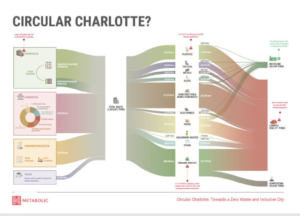
Image from the Report Circular Charlotte
Understanding What You Are Throwing Away
Ms. Yates says that “The only way to become a more circular city is to understand what you’re throwing away.” Her consultant, Metabolic, conducted a waste analysis showing that in Charlotte, over a million tons of waste a year are disposed of. 944,000 tons of the 1 million tons of waste goes to landfill with 26.3 percent of content that could potentially be recycled through existing programs. She pointed out that in Charlotte, “We have 66,000 tons that are recycled and 56,000 tons that go into composting. A large portion of our waste is also construction and demolition waste because we’re a growing city. “
Working with Community Groups and Businesses
The Circular Charlotte strategy lays out a roadmap to a circular economy, with the first step being gathering data and conducting a landscape assessment. In addition to knowing about how waste is moving through the system in Charlotte, it is also valuable to know who is working in that space in terms of community groups, businesses, etc. that can collaborate in order to help promote a circular economy. As part of that, the project team came up with some business cases that identified the potential for quick wins to sustain the buy-in from leadership.
They created a cohort of businesses that would offer discounts on materials to encourage the recycling and reuse of materials. For example, if one business had a waste product and were able to supply another business with that product, then they could participate in a special discount program available to people in that circular economy network. Ms. Yates provided additional examples of innovation taking place in Charlotte pertaining to black soldier fly composting and concrete recycling. Another interesting example from the Netherlands was shoes being made from avocado peels!
Education for a Rapidly Changing World & Workforce
The panel noted a statistic that 65% of children entering primary school today will ultimately end up working in completely new job types that don’t yet exist.[1]Innovation can often take place so fast that it makes it impossible to predict the jobs of the future. This example came up on the panel in regard to new modes of microtransit, such as electric scooters, mopeds, electric bikes, etc. that are becoming market disrupters for companies such as Uber and Lyft. To make the necessary transformation to our economy recommended by our scientists to avoid runaway climate change and other key environmental stressors, it appears that the demand for new skills and careers in this sector will continue to grow.
[1]The Future of Jobs, World Economic Forum, http://reports.weforum.org/future-of-jobs-2016/chapter-1-the-future-of-jobs-and-skills/
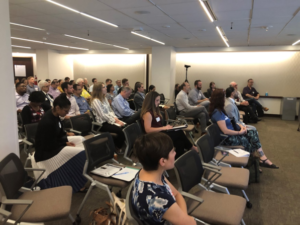
Green Jobs Forum audience listening to panel (Photo Credit – Denise Nelson)

Green Jobs Exhibitors (Photo Credit, Denise Nelson)
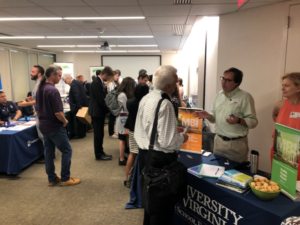
Educators Green Jobs Exhibit (Photo Credit – Denise Nelson)
Janine Finnell serves as the Executive Director of Leaders in Energy (LE), a global action network, which is dedicated to advancing clean energy and sustainable solutions. She would like to acknowledge the contribution of LE member and volunteer, Xavier Vergara, who provided notes from the session.
[1]Bioswales are linear channels designed to concentrate and convey stormwater runoff while removing debris and pollution. Bioswales can also be beneficial in recharging groundwater. Bioswales are typically vegetated, mulched, or xeriscaped. They consist of a swaled drainage course with gently sloped sides.
[2]The Corporate Average Fuel Economy standards are regulations in the United States, first enacted by the United States Congress in 1975, after the 1973–74 Arab Oil Embargo, to improve the average fuel economy of cars and light trucks produced for sale in the United States.
[3]Additionality is a term that describes renewable energy generation that is truly new – i.e. additional. For example, companies responsible for financially supporting new, expanding, or developing renewable generation sources, as opposed to buying into what is already available or planned, can claim additionality.
[4]The Future of Jobs, World Economic Forum, http://reports.weforum.org/future-of-jobs-2016/chapter-1-the-future-of-jobs-and-skills/



Leave a Reply